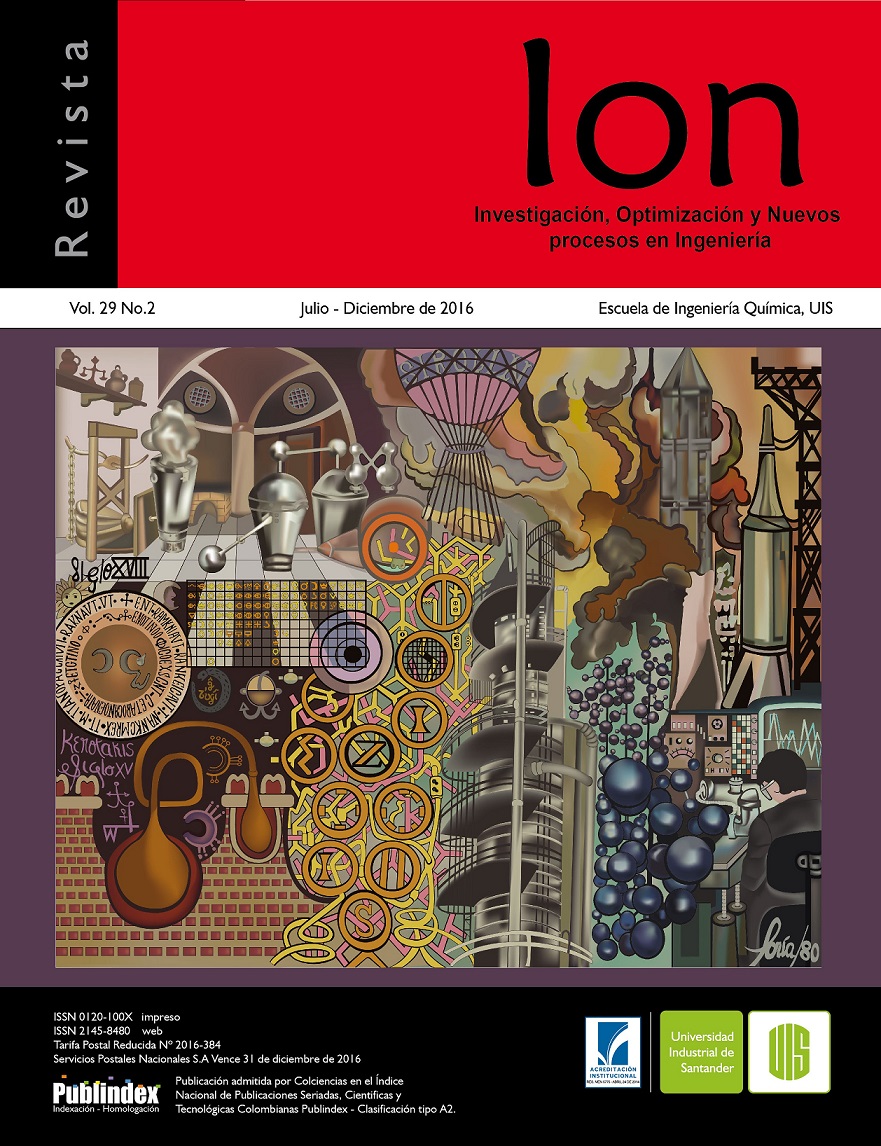Bromine number prediction for Colombian naphthas using near-infrared spectroscopy and chemometric methods
Published 2016-12-15
Keywords
- FT-NIR,
- Naphtha,
- Bromine Number,
- PCA,
- PLS
- MPR. ...More
How to Cite
Abstract
Thirty-eight naphtha samples were used to develop a chemometric method to predict bromine number. All samples were characterized by Fourier transform near infrared spectroscopy (FT-NIR), and their spectra were correlated by similarity using principal component analysis (PCA). The models for bromine number determination (BN) were established by Partial Least Squares regression (PLS) and Multiple Polynomial Regression (MPR). PCA allowed classifying the samples into the light and heavy, determining the most significant spectral variables. These variables are located in the regions between 4000-4800 and 5200-6350cm-1. The results determined by combining FT-NIR spectroscopy and chemometrics were very close to those obtained by standardized methods. This approach may be an alternative for analysis of BN, which requires sample turnarounds lower than five minutes and lower cost compared to traditional methods.
Downloads
References
[2] Falla FS, Larini C, Le Roux GAC, Quina FH, Moro LFL, Nascimento CAO. Characterization of crude oil by NIR. J Petrol Sci Eng. 2006;51(1– 2):127–37.
[3] Borges B, Acevedo S. Caracterización estructural de distintas fracciones aisladas del crudo extrapesado de Carabobo. Rev. Latinam. Metal. Mater. 2007;27(2):83–94.
[4] Mullins OC. The Modified Yen Model. Energy Fuels. 2010;24(6):2179–207.
[5] Bezerra De Lira L, Vera F, Fernandes C, Silveira AP, Stragevitchb L, Pimentel MF. Prediction of properties of diesel/biodiesel blends by infrared spectroscopy and multivariate calibration. Fuel. 2010;89:405–9.
[6] Orrego-Ruiz JA, Guzmán A, Molina D, MejíaOspino E. Mid-infrared Attenuated Total Reflectance (MIR-ATR) predictive models for asphaltene contents in vacuum residua: asphaltene structure–functionality correlations based on Partial Least-Squares Regression (PLS-R). Energy Fuels. 2011;25:3678–86.
[7] Orrego-Ruiz JA, Mejía-Ospino E, Carbognani L, López-Linares F, Pereira-Almao P. Quality Prediction from Hydroprocessing through Infrared Spectroscopy (IR) Energy Fuels. 2012;26:586–93.
[8] Meléndez LV, Lache A, Orrego-Ruiz JA, Pachón Z, and Mejía-Ospino E. Prediction of the SARA analysis of Colombian crude oils using ATR– FTIR spectroscopy and chemometric methods. J. Pet. Sci. Eng. 2012;90-91:56–60.
[9] Chung H, Ku M, Lee JS. Comparison of nearinfrared, infrared, and Raman spectroscopy for the analysis of heavy petroleum products Appl. Spectrosc. 2000;54:239–45.
[10]ASTM D1159–07, Standard Test Method for Bromine Numbers of Petroleum Distillates and Commercial Aliphatic Olefins by Electrometric Titration, ASTM International, West Conshohocken, PA, 2012.
[11] Carbognani L, Lopez-Linares F, Trujillo M, Wu Q, Carbognani J, Pereira-Almao P. On the determination of olefins in heavy oil, bitumen and their upgraded products. Div. Energy Fuels. ACS Energy Fuels Preprints. 2012;57:685-8.
[12]Fusheng O, Xu PXuhong, Z, Xuan L, Huixin W. Effect of Operating Conditions on Olefin Distribution in FCC Gasoline as Part of an Olefin Reduction Process China Pet. Process. Petrochem. Process. 2010;12:34-42
[13]Wold S. Chemometrics; what do we mean with it, and what do we want from it? Chemom. Intell. Lab. Syst. 1995;30:109–15.
[14]N. Aske, H. Kallevik, J. Sjöblom. Determination of saturate, aromatic, resin and asphaltenic (SARA) components in crude oils using infrared and near-infrared spectroscopy. Energy Fuels. 2001;15:1304–12.
[15]Satya S, Roehner RM, Deo MD, Hanson FV. Estimation of properties of crude oil residual fractions using chemometrics. Energy. Fuels. 2007;21:998–1005.
[16]Syunyaev RZ, Balabin RM. Frequency dependence of oil conductivity at high pressure. J. Disp. Sci. Technol. 2007;28:419-27.
[17]Syunyaev RZ, Balabin RM. Polarization of Fluorescence of Asphaltene Containing Systems. J. Disp. Sci. Technol. 2008;29:1505- 14.
[18] Kaplan IG. Intermolecular Interactions: Physical Picture, Computational Methods and Model Potentials. México: John Wiley & Sons; 2006.
[19] Wold S, Sjöström M, Eriksson L. PLS-regression, a basic tool of Chemometrics. Chemom. Intell. Lab. Syst. 2001;58:109-30.
[20] Cheung V. A comparative study of the characterization of colour cameras by means of neural networks and polynomial transforms. Color. Technol. 2004;120:19-25

